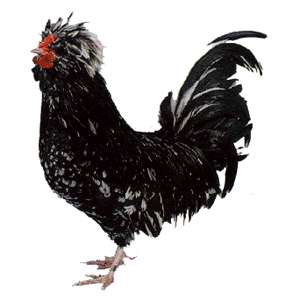
Breed Overview
The Houdan Chicken is an old French dual-purpose breed, which was earlier known as the Normandy fowl when it was first imported into England in 1850.
It takes its current name from the town of Houdan, located in a section of France where large numbers of this breed were bred and raised in recent years for the chicken markets in Paris and London.
The Houdan is rated highly in France for its fine meat qualities. The Houdan was first imported into America in 1865. The White variety of Houdan was created in America as a result of crossing White Polish chickens with Mottled Houdans.
Male Houdan chickens weigh on average 8lbs (3.6kgs) and females weigh on average 6.5lbs (3kgs).
Eggs
Size
Medium sized eggs
Color
White eggs
Production per year
160 eggs per annum
When do they start laying eggs?
From 20 weeks
Houdan Characteristics
Temperament / Are they good as pets?
Houdan chickens are a docile breed that make for good pets as they are calm and friendly. They can outlive most other breeds.
How do I tame Houdan chickens?
Holding your chicks whilst they are still young to get them accustomed to human contact is the easiest way to tame chickens. If you have older chickens that you want to tame, you can try feeding them out of your hand.
How many do I need to buy?
Chickens get lonely when they are kept by themselves so need to have at least 1 other friend. A good small flock size is 6 chickens.
How much space do they need?
This breed doesn’t mind being kept in confinement but also does well as a free rage bird. If you’re keeping your chickens in a run then you need a minimum of 25 square feet per chicken.
Will they mix with my other chickens?
Yes, they should mix easily with any existing chickens that you have.
Appearance
There are only three popular varieties of plumage: lavender, black and mottled which is the most common variety. They have a noticeably large crest and a big head covered in feathers that stick up and out giving the appearance of a mane.
They have white earlobes that can’t be seen as they are hidden by their feathers. Their legs should be clean of feathers and black in color.
Feeding
What should I feed them?
When your chicks first hatch they need to be fed growers mash as this has a higher protein content than standard chicken feed and also has all the good stuff in it that they’ll need to grow up to be healthy chickens.
Your chickens at 6 weeks can be switched to standard chicken pellets which usually have around 15-16{cfcd481556a8b43fba6af451761032bd323e94372a0c1e607} protein.
Now slightly before they near laying age, usually around 16 weeks, you can start introducing layers mash or layers pellets into their diet. This has around 16{cfcd481556a8b43fba6af451761032bd323e94372a0c1e607} protein and have the vitamins they need to help with egg production.
How much should I feed them?
Chickens eat around ¼ of a pound (113g) of feed each a day. You can give them this amount to test how much of this they eat.
If they eat all of this quickly you should up the amount of feed you’re giving them. You can leave the feed in a feeder for them to pick at whenever they please.
What can’t they eat?
There is a detailed outline of all the things chickens can’t eat on the feed section of our page. A general rule of thumb is that if it’s not fit for you to consume then it’s probably not fit for your chickens to eat, so don’t give them any moldy food.
Chocolate and beans should be avoided by chickens as they contain theobromine and phytohemagglutinin which can cause a whole range of health problems if consumed and can potentially be fatal.
What do I need to keep chickens?
The first thing you should buy when kitting out your space for your chickens is a chicken coop. Make sure the coop has enough space; there should be 11 square feet per chicken. Inside the coop should be a perch for each chicken so that they have somewhere to sleep at night. You need some laying boxes as well where they can lay their eggs.
If you’re keeping your chickens in a run you need to make sure that has a run which has at least 25 square feet per bird. The run should have a fence around it and the coop needs a sunken fence the whole way around and over the top of in order to keep your chickens safe from any predators. They need a specialized water container as they have a large crest or you can have a standard water container but just make sure to not fill it up to the top.
The last thing you need, which is especially important as your chickens reach maturity, is grit. If you have no natural grit on hand you need to buy some as this is really important for egg production.
